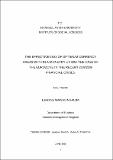Please use this identifier to cite or link to this item:
http://hdl.handle.net/11547/8745| Title: | THE EFFECTIVENESS OF OPTIMUM CURRENCY AREAS WITHIN A MONETRY UNION: THE CASE OF THE EUROZONE IN THE RECENT 2008/2009 FINANCIAL CRISES. |
| Authors: | NGALIM, Lawrence MAISHU |
| Keywords: | Eurozone Euro Exchange rate volatility Monetary regimes Optimum Currency Areas Trade flows , Maastricht convergence criteria Monetary policy |
| Issue Date: | 2015 |
| Abstract: | Since 2008, it‟s argued that the financial crisis in the Euro zone has demonstrated that the region was not mature enough to adopt the euro as a currency. A retrospect on the Maastricht convergence criteria and on the Optimum Currency Criteria put forth, clearly points out the deviations in the fulfillment of these criteria in the conception and functionality of the so-called euro area. The goal of this research is to measure the effects of the 2008 financial crisis in the Eurozone by considering exchange rate volatility (risk) on trade flows between the United States and the Eurozone. The null hypothesis being that exchange rate volatility affects trade flows and consequently renders monetary policies ineffective was tested against the alternative hypothesis. This research is prepared in two main parts; in the first part, a review of relevant literature of optimum currency areas is considered, followed by a careful track-down of the euro area monetary systems. The first part concludes in finding out if truly the euro area is an example of a currency area. The second part is the technical frame of the research; an econometric model is applied on trade flows and exchange rate variations, in order to test the Eurozone as an optimal currency area the study employed a conditional autoregressive distributed lag model as its empirical methodology, which verifies co-integration between variables and further differentiate the short and long run impacts. The selection of the appropriate model or the lag length is based on Schwarz Information Criterion and Akaike Information Criterion. The data is a quarterly time series data from 1999 to 2014, which provides enough observations for the time-series econometric model. The last part pays special attention to the Greek economy vis-à-vis the on-going financial turmoil. An analysis on the future of the European monetary system is equally evoked while incorporating the newest reactions/debates as regards the on-going crisis in the Euro zone. After the technical analysis of trade flows, exports were found to be more sensitive than imports to exchange rate volatility. The short run causality effects were generally minimal and the speed of recovery back to the macroeconomic equilibrium was higher in exports. In definitive, the euro area is not a perfect example of a currency club as pointed out by the transfer of asymmetric shocks to members. |
| URI: | http://hdl.handle.net/11547/8745 |
| Appears in Collections: | Tezler -- Thesis |
Files in This Item:
| File | Description | Size | Format | |
|---|---|---|---|---|
| 10084433.pdf | 2.29 MB | Adobe PDF |  View/Open |
Items in DSpace are protected by copyright, with all rights reserved, unless otherwise indicated.
